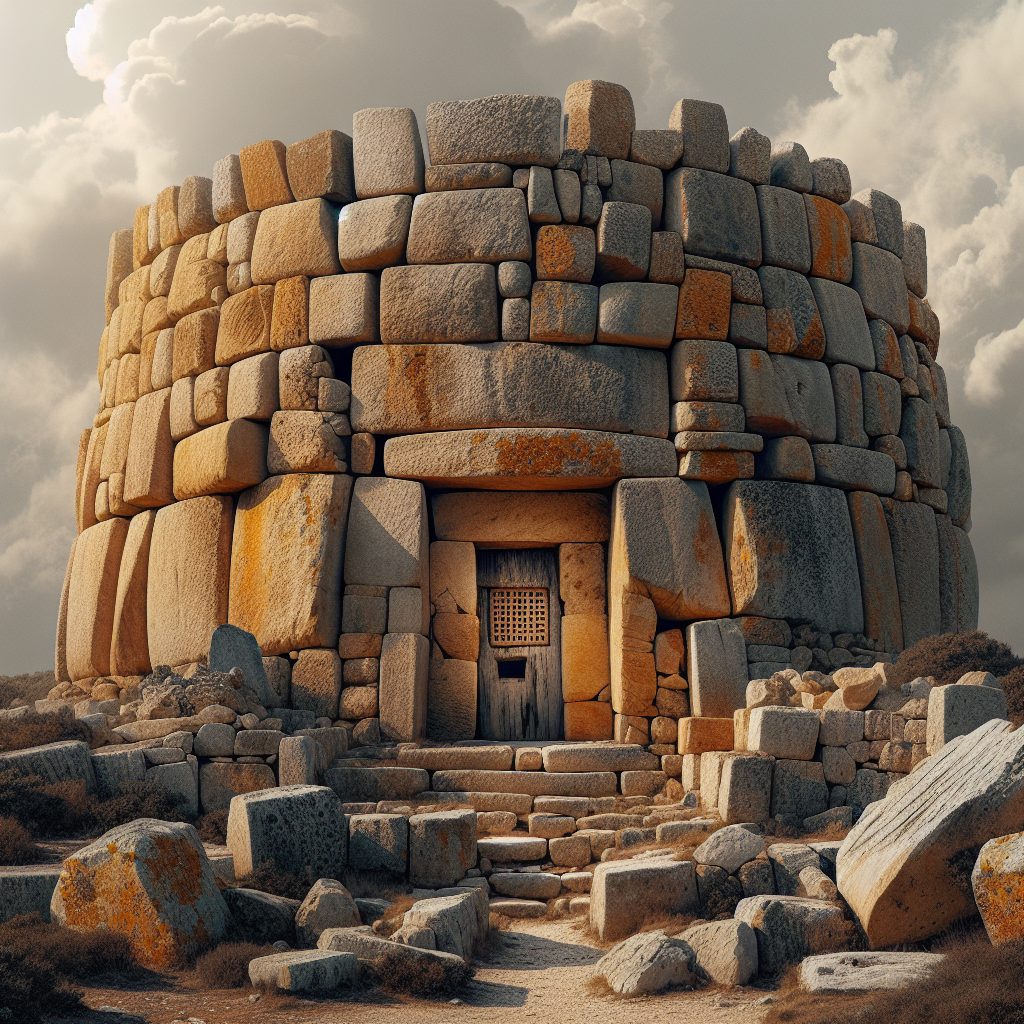Nuraghe, a term originating from the Sardinian language, refers to the ancient stone dwellings and defensive towers found on the island of Sardinia, Italy. These unique structures hold immense historical significance and offer a fascinating insight into the centuries-old Nuragic civilization. With over 7,000 nuraghes scattered across the island, these architectural marvels showcase the ingenuity and skills of the ancient Sardinians. The nuraghes served as fortified settlements, acting as both defensive structures and administrative centers, allowing for the development of complex societies within the island’s prehistoric landscape.
One of the most striking aspects of the Nuragic civilization is their impressive construction techniques. Built using large blocks of stone, the nuraghes stand as a testament to the ancient Sardinians’ architectural prowess. Each structure is composed of overlapping layers of stone, forming a conical or cylindrical tower with an internal staircase that leads to multiple levels. The durability of these ancient buildings is astounding, given that some nuraghes have remained intact for more than three millennia. This architectural expertise not only showcases their mastery of stone masonry but also suggests a well-developed understanding of engineering principles long before the rise of modern civilization.
As we delve deeper into the world of nuraghes, we will uncover their significant impacts on Sardinian society and archaeology. In the subsequent parts of this article, we will explore the various types of nuraghes, their cultural and economic significance, and the ongoing efforts to preserve and study these exceptional remnants of the past. Join us as we unravel the secrets of the nuraghes, their intricate designs, and the stories they have to tell about an ancient civilization that shaped the development of the Mediterranean region.
Key Takeaways
1. Nuraghe structures are ancient stone towers found on the Mediterranean island of Sardinia, serving as the defining architectural symbol of the Nuragic civilization that thrived from 1800 to 000 BCE.
2. These mysterious structures were built using cyclopean construction techniques, featuring massive stones that were carefully stacked without the use of mortar or any other bonding agent, indicating advanced engineering skills of the Nuragic people.
3. Nuraghe complexes were multifunctional, serving as defensive structures, religious sanctuaries, and centers of social and economic activity, with some housing entire communities.
4. These impressive stone structures are a testament to the highly advanced knowledge and skills possessed by the Nuragic civilization, who were able to create enduring architectural marvels that have withstood the test of time.
5. The Nuraghe sites are not only significant for their historical value but also for their cultural significance, as they provide valuable insight into the lives, beliefs, and societal structures of the Nuragic people, contributing to a better understanding of their civilization and its legacy.
h1: What is the Historical Significance of Nuraghe?
Nuraghe, an ancient stone tower found primarily in Sardinia, Italy, holds great historical significance. These unique structures date back to the Bronze Age and were built by the Nuragic civilization, which flourished on the island. The Nuraghe complexes consist of a central tower surrounded by additional smaller towers, walls, and courtyards. Let’s explore the various aspects of the historical significance associated with Nuraghe.
h2: Architectural Marvels of the Nuraghe Structures
The Nuraghe structures showcase exceptional architectural achievements of the ancient Nuragic civilization. These ancient towers were constructed without the use of mortar, using only stones, which were superbly fitted together. The intricate design and engineering techniques employed in creating these massive stone structures still intrigue archaeologists and historians today. The architecture of Nuraghe is not only remarkable but also reflects the advanced knowledge of the Nuragic people.
h3: Symbolic Significance and Purpose of Nuraghe
As impressive landmarks, Nuraghe held significant symbolic meaning for the Nuragic civilization. The structures were likely used for various purposes, such as defensive forts, temples, or administrative centers. Scholars believe that Nuraghe played a central role in the social, political, and religious life of the ancient Sardinians. Their strategic locations, often perched on hilltops, indicate their defensive purpose and control over the surrounding territories.
h3: Cultural Insights and Historical Context
Studying the Nuraghe structures provides valuable insights into the culture and history of the Nuragic civilization. The artifacts found within the Nuraghe sites, such as pottery, bronze objects, and jewelry, offer a glimpse into the everyday life, craftsmanship, and artistic abilities of the ancient inhabitants. The Nuraghe complexes also serve as a testament to the complex social organization and hierarchical structure of the Nuragic society.
h2: Nuraghe’s Influence on Sardinian Identity
The Nuraghe structures hold deep cultural significance for the people of Sardinia. As iconic symbols of their ancient heritage, they have become an integral part of Sardinian identity. Nuraghe complexes are not only admired for their historical value but also celebrated in local folklore, literature, and art. The preservation and promotion of these structures contribute to the pride and collective memory of the Sardinian community.
h2: Tourism and Nuraghe
Nuraghe sites attract thousands of visitors each year, contributing significantly to the tourism industry in Sardinia. Tourists are drawn to the mystery and historical value associated with these ancient structures. Exploring the Nuraghe complexes provides visitors with a unique opportunity to immerse themselves in the rich history and culture of Sardinia. The tourism industry surrounding Nuraghe also supports local economies and the preservation efforts of these archaeological sites.
h1: What are the Tips to Visit and Appreciate Nuraghe?
1. Plan your Visit: Research and determine which Nuraghe sites you would like to visit, as there are numerous locations across Sardinia.
2. Guided Tours: Consider joining a guided tour to gain a better understanding of the historical significance and cultural context associated with Nuraghe.
3. Learn about Nuragic Civilization: Familiarize yourself with the history, culture, and archaeological findings related to the Nuragic civilization before your visit.
4. Explore Multiple Sites: If time permits, visit multiple Nuraghe sites to appreciate the diversity in architectural styles, sizes, and geographical locations.
5. Respect the Structures: Nuraghe complexes are fragile and historic sites. Follow the rules and guidelines provided by the authorities to ensure the preservation of these important landmarks.
6. Study the Artifacts: Take time to observe the artifacts on display within the Nuraghe sites, as they offer insights into the ancient civilization’s craftsmanship and daily life.
7. Appreciate the Landscapes: Many Nuraghe sites are located in picturesque landscapes. Take a moment to appreciate the natural beauty surrounding these historical structures.
8. Attend Cultural Events: Check if there are any cultural events or exhibitions related to Nuraghe during your visit to enhance your experience and understanding.
Remember, by understanding and appreciating the historical significance of Nuraghe, you can truly immerse yourself in the rich cultural heritage of Sardinia.
Nuraghe Historical Significance – FAQ
1. What is a Nuraghe and why is it historically significant?
A Nuraghe is a type of ancient megalithic structure found in Sardinia, Italy. These impressive stone towers were built by the Nuragic civilization during the Bronze Age, between 1800 BC and 500 BC. They hold great historical significance as they represent the advanced architectural skills and engineering knowledge of the Nuragic people.
2. How many Nuraghes are still standing today?
It is estimated that there are over 7,000 Nuraghes scattered throughout Sardinia. Although many have been destroyed over time due to natural disasters and human intervention, a significant number of these structures still stand today, attracting tourists and archaeologists from around the world.
3. Were Nuraghes used for defensive purposes?
Yes, Nuraghes were primarily used as defensive structures. They were strategically built to allow for effective observation of the surrounding territory, providing protection against potential threats. Some Nuraghes feature multiple floors, interconnected rooms, and hidden passages, showcasing their defensive nature.
4. What was the purpose of Nuraghes besides defense?
While defense was a crucial aspect, Nuraghes also served as symbols of power, prestige, and social organization within the Nuragic civilization. They were likely used as residences for important individuals, ceremonial sites, and centers for religious rituals. Additionally, they might have played a role in the economic activities of the time, such as controlling the surrounding agricultural lands.
5. How were Nuraghes constructed?
Nuraghes were built using large stones, usually without the use of mortar. The stones were carefully carved and fitted together to create the circular or tholos-shaped towers. The construction techniques varied across different regions in Sardinia, suggesting a decentralized approach to building these structures. Some Nuraghes reached impressive heights, with their walls tapering inward as they ascended.
6. What is the current state of conservation for Nuraghes?
The conservation of Nuraghes is a continuous effort. Many have been restored or partially reconstructed, while others are in a state of decay or ruin. Various archaeological sites and organizations work towards their preservation, aiming to protect these unique cultural heritage sites for future generations.
7. Can visitors explore and enter Nuraghes?
Yes, in many cases visitors are allowed to explore and enter Nuraghes, although regulations may vary depending on the specific site. Some Nuraghes have designated paths and guided tours to ensure the preservation of the structures and to provide visitors with valuable insights into their historical and architectural features.
8. Are there any museums dedicated to Nuragic civilization?
Absolutely! There are several museums in Sardinia dedicated to showcasing the artifacts, history, and culture of the Nuragic civilization. Museo Archeologico Nazionale di Cagliari and Museo Nazionale Archeologico ed Etnografico G.A. Sanna are two prominent examples where visitors can immerse themselves in the world of the Nuragic people.
9. Are there any UNESCO World Heritage Sites related to Nuraghes?
Yes, several Nuraghe sites in Sardinia have been recognized as UNESCO World Heritage Sites due to their outstanding universal value. This includes sites like Su Nuraxi di Barumini, which are remarkable examples of Nuragic architecture and provide valuable insights into the ancient civilization’s way of life.
10. Can Nuraghes be visited year-round?
Yes, Nuraghes can be visited year-round, although peak tourist season in Sardinia typically occurs during the summer months. Spring and autumn can be great times to visit as the weather is pleasant, and there are fewer crowds. It’s always advisable to check the opening hours and accessibility of specific Nuraghe sites before planning a visit.
Final Thoughts
Exploring the historical significance of Nuraghes not only provides a glimpse into the Nuragic civilization’s architectural achievements but also highlights the rich cultural heritage of Sardinia. These megalithic structures stand as timeless testaments to the legacies of our ancestors, reminding us of the incredible craftsmanship and ingenuity of past civilizations. Visiting Nuraghes offers a unique opportunity to connect with history and experience the awe-inspiring beauty of these ancient structures, immersing oneself in a journey through time.
Whether you’re a history enthusiast, an archaeology lover, or simply intrigued by unique ancient structures, a visit to the Nuraghes is an experience that will leave a lasting impression. Witnessing these imposing stone towers and delving into the secrets they hold is a captivating adventure, allowing you to appreciate the profound historical significance attributed to these remarkable pieces of our human heritage.






